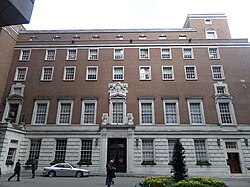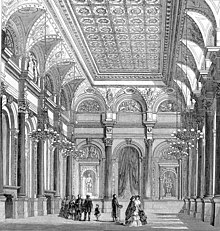Clothworkers' Hall
| Clothworkers' Hall | |
|
Middlesex | |
|---|---|
 Clothworkers' Hall | |
| Type: | Livery hall |
| Location | |
| Grid reference: | TQ33268091 |
| Location: | 51°30’41"N, 0°4’52"W |
| City: | London |
| History | |
| Address: | Dunster Court |
| Built 1958 | |
| For: | The Worshipful Company of Clothworkers |
| Livery hall | |
| Modern Neo-Classical | |
| Information | |
| Owned by: | The Worshipful Company of Clothworkers |
Clothworkers' Hall is the livery hall of the Worshipful Company of Clothworkers, one of the privileged livery companies of the City of London. It stands within Dunster Court, a precinct between Mincing Lane and Mark Lane, in the City.
Though modern in date, having been built in 1958 after its predecessor was destroyed in the Blitz, the hall follows a beautifully proportioned neo-Classical style externally.
The Clothworkers' Company was incorporated by Royal Charter in 1528, formed by the amalgamation of its two predecessor companies, the Fullers (incorporated in 1480) and the Shearmen (incorporated in 1508). It succeeded to the position of the Shearmen's Company in the City's order of precedence and thus ranks twelfth in the order of precedence amongst the Livery Companies, and is one of the Twelve Great Companies.
History
The site of Clothworkers' Hall on Mincing Lane was conveyed to a group of Shearmen in 1456, who built that Company's hall here.
In 1528, the Shearmen's Company and the Fullers' Company amalgamated to form The Clothworkers' Company, which took over the old livery hall of the Shearmen. In 1548 the Company built a new livery hall on the same site.
By the reign of King James I, the company was very wealthy and influential: in 1606 the King became a Clothworker, and in 1609 the Company invested in both the plantation of Ulster (and with it the foundation of the City of Londonderry) and in the plantation of Virginia.
In 1633, the third Clothworkers' Hall was built. This stood for just 33 years, until in 1666 it was destroyed in the Great Fire of London. A new hall, the fourth, was built after the fire.
In 1860, a new Clothworkers' Hall was built, designed by Samuel Angel. This hall was destroyed in the Blitz, in 1941.[1]
The present Clothworkers' Hall was completed in 1958; the sixth on the site. The hall provides a headquarters for the Clothworkers' Company and for the Clothworkers' Foundation, a charity founded by the Company.
The Company
The original craft of the Clothworkers was the finishing of woven woollen cloth: fulling it to mat the fibres and remove the grease, drying it on tenter frames, raising the nap with teasels and shearing it to a uniform finish. The Ordinances of The Clothworkers' Company, first issued in 1532 and signed by Sir Thomas More, sought to regulate clothworking, to maintain standards and to protect approved practices.
From the later Middle Ages, cloth production gradually moved away from London, and at the Industrial Revolution of the 18th and 19th centuries very little was left as the great mills of Lancashire, Lanarkshire, Yorkshire and the Midlands churned out mile upon mile of cloth of wool and cotton.
Today the Company's main role is in the charitable sphere, through the Clothworkers' Foundation, an independent charity. Through its grants, the Foundation seeks to improve the quality of life, particularly for people and communities that face disadvantage.
Outside links
References
- ↑ The London Encyclopaedia. London: Pan Macmillan. 2011. p. 178. ISBN 9780230738782. https://books.google.co.uk/books?id=xa0D0PqiwfEC&dq.
| Livery Halls of the City of London |
|---|
|
Apothecaries • Armourers • Bakers • Barber-Surgeons • Brewers • Butchers • Carpenters • Chartered Accountants • Clothworkers • Coopers • Cutlers • Drapers • Dyers • Farmers & Fletchers • Fishmongers • Founders • Furniture Makers • Girdlers • Glaziers • Goldsmiths • Grocers • Haberdashers • Information Technologists • Innholders • Ironmongers • Leathersellers • Mercers • Merchant Taylors • Painters • Pewterers • Plaisterers • Saddlers • Salters • Skinners • Stationers • Tallow Chandlers • Vintners • Watermen • Wax Chandlers • HQS Wellington • |
